Description Page - Doosan Power Systems
Description Page - Doosan Power Systems
Description Page - Doosan Power Systems
Create successful ePaper yourself
Turn your PDF publications into a flip-book with our unique Google optimized e-Paper software.
Notes to the financial statements<br />
1. Accounting policies<br />
A summary of the principal accounting policies, all of which have been<br />
applied consistently throughout the period and the preceding period, is<br />
set out below.<br />
Basis of Preparation<br />
The financial statements have been prepared under the historical cost<br />
convention. The financial statements are prepared in accordance with<br />
applicable accounting standards, and on the going concern basis.<br />
As the Company is a 100% owned subsidiary of <strong>Doosan</strong> Corporation Co.,<br />
Ltd, the Company’s voting rights are controlled within the Group.<br />
Therefore the Company has taken advantage of the exemption<br />
contained in Financial Reporting Standard (FRS) 8 and has not disclosed<br />
transactions or balances with entities which form part of the <strong>Doosan</strong><br />
Corporation Co., Ltd Group. The accounts of <strong>Doosan</strong> Corporation Co.,<br />
Ltd are available from the address in note 26.<br />
Basis of Consolidation<br />
The Group financial statements comprise a consolidation of the<br />
accounts of the Company and its subsidiary undertakings at 31<br />
December 2007. The acquisition method of accounting has been<br />
adopted. Under this method the profits and losses of the subsidiary<br />
undertaking are consolidated from its date of acquisition or up until the<br />
date of disposal as appropriate.<br />
The Group financial statements include the appropriate share of the<br />
results and net assets of joint ventures and associates accounted for<br />
using the gross equity method. Joint ventures are entities in which the<br />
Group has a long term interest and shares control with another party or<br />
parties. Associates are entities in which the Group has a long term<br />
interest and exercises a significant influence with another party or<br />
parties.<br />
Joint Arrangements<br />
The Group has certain contractual arrangements with other participants<br />
to engage in joint activities that do not create an entity carrying on a<br />
trade or business of its own. The Group includes its share of assets,<br />
liabilities and cash flows in such joint arrangements, measured in<br />
accordance with the terms of each arrangement, which is usually prorata<br />
to the Group’s interest in the joint arrangement.<br />
Goodwill<br />
Purchased goodwill (both positive and negative) in respect of<br />
acquisitions before 1 January 1998, when FRS 10 Goodwill and<br />
intangible assets was adopted, was written off to reserves in the year of<br />
acquisition. When a subsequent disposal occurs any related goodwill<br />
previously written off to reserves is written back through the profit and<br />
loss account as part of the profit or loss on disposal.<br />
Purchased goodwill (representing the excess of the fair value of the<br />
consideration given over the fair value of the separable net assets<br />
acquired) in respect of acquisitions since 1 January 1998 is capitalised.<br />
Positive goodwill is amortised to nil by equal annual instalments over<br />
20 years (or its estimated useful life if shorter).<br />
DOOSAN BABCOCK ENERGY<br />
Annual Report and Financial Statements 2007<br />
Negative goodwill in respect of acquisitions after 1 January 1998 is<br />
included within fixed assets and released to the profit and loss account<br />
in the periods in which the fair values of the non-monetary assets<br />
purchased on the same acquisition are recovered, whether through<br />
depreciation or sale.<br />
Foreign Currencies<br />
(a) Foreign currency transactions:<br />
Transactions in foreign currencies are translated at the foreign exchange<br />
rate ruling at the date of the transaction. The monetary assets and<br />
liabilities denominated in foreign currencies at the balance sheet date<br />
are translated to pounds sterling at the foreign exchange rate ruling at<br />
that date. Foreign exchange differences arising on translation are<br />
recognised in to the profit and loss account.<br />
(b) Financial statements of foreign operations:<br />
The monetary assets and liabilities of foreign operations are translated<br />
to pounds sterling at the foreign exchange rate ruling at the balance<br />
sheet date. The trading results of foreign operations are translated to<br />
pounds sterling at the average foreign exchange rate ruling during the<br />
period; this represents a change of policy from previous years when the<br />
foreign exchange rate ruling at the balance sheet date was used; this<br />
change does not have a material impact on the financial statements and<br />
accordingly there is no restatement of prior period figures. On<br />
consolidation exchange differences arising from the retranslation of the<br />
opening net investment in foreign operations and the result for the<br />
period are recognised in reserves.<br />
Turnover<br />
Turnover, which excludes sales within the Group and value added and<br />
similar taxes, comprises:-<br />
(a) Contract work - amounts transferred to cost of sales plus attributed<br />
profit. A major part of the activity of the Group comprises long term<br />
contracts. Such contracts are subject to regular detailed financial<br />
and technical review to determine the estimated costs to<br />
completion. A proportion of profits earned on contracts is credited in<br />
the accounts on a prudent basis as work progresses, according to<br />
the stage of completion. Full provisions are made in respect of<br />
foreseeable losses on uncompleted contracts.<br />
(b) Sales (other than contract sales) of goods and services at invoiced<br />
value.<br />
(c) Fees for technical aid and other services rendered.<br />
Research and Development<br />
Development expenditure on clearly defined projects, the commercial<br />
outcome of which can be assessed with reasonable certainty, is<br />
capitalised within intangible fixed assets. Such capitalised expenditure<br />
is amortised over the shorter of the project life and seven years. All<br />
other research and development expenditure is written off as incurred.<br />
25



